Experts explore reconstruction of global industrial chain

The COVID-19 pandemic is reshaping the global industrial chain, which has brought both challenges and opportunities to China.
The global industrial chain is the process of optimizing and expanding the production boundaries of enterprises worldwide, said Liu Qing, a professor from the National Academy of Development and Strategy at Renmin University of China (RUC). The modern global industrial chain began to take shape in the 1980s and 1990s. Historical events such as the end of the Cold War and China’s reform and opening up have injected vitality into the world’s economic development, changed the structure of global factors of production, promoted technological progress, improved global governance rules and promoted globalization, thus boosting the global industrial chain.
In recent years, with the development of the fourth industrial revolution represented by AI and intelligent manufacturing, labor costs have been greatly reduced. The weakening of economic globalization, liberalization and global governance rules has significantly increased global transaction risks and increased economic uncertainty. In the future, the global industrial chain will focus more closely on market demand and witness a new model of regional agglomeration, Liu predicted.
Liu Zhibiao, director of the Yangtze IDEI at Nanjing University, said the business philosophy of multinationals may change in the future. The global industrial chain will tend to be shortened. The products originally subcontracted to different countries and enterprises will be moderately withdrawn to the internal production of multinationals, and the vertical division of labor systems that target production processes and links will change. This does not meet the characteristics of comparative advantage theory and economies of scale, but meets the requirements of shortening the supply chain to make the industry autonomous and controllable. The future division of labor will tend to be regionalized. This inward trend of the industrial chain may harm the interests of the international division of labor, but is conducive to improving economic efficiency.
The pandemic has not changed the basic pattern of production regionalization and trade globalization, but the global multilateral economic and trade consultation mechanism has been weakened and the regional economic and trade cooperation multilateral mechanism has been strengthened, according to Yu Miaojie, Party secretary of the National School of Development at Peking University. For example, China’s Belt and Road initiative has received an active response, ASEAN’s Regional Comprehensive Economic Partnership has been further established, and the free trade zone created by the North American Free Trade Agreement has been strengthened, as well as the Comprehensive Progressive Trans-Pacific Partnership led by Japan.
To weigh the restructuring of the global industrial chain, it is necessary to compare the costs and risks of enterprises, Liu Qing said. The global industrial chain can optimize resource allocation and reduce enterprise costs on a global scale, but the longer the global industrial chain, the greater its risks. In addition, the impact of international political competition and national economic security must also be considered. The safer the national economy is, the more beneficial it is to enhance its competitiveness in the global industrial chain; the more intense the international political competition, the higher the risk of the global industrial chain.
In recent years, the share of trade in GDP has continued to shrink, and the world has fallen into a stagnation state of low growth, low trade, low interest rates and low inflation, observed RUC Vice President Liu Yuanchun. Moreover, costs and risks are increasing, regionalization is on the rise, and international political conflicts and geopolitical conflicts have adversely affected the economy.
This pandemic may aggravate the long-term stagnation of the world economy, Liu Yuanchun warned. The next few years will be a key period and a turning point for new technologies, and countries should formulate strategies and make changes at various stages.
Liu Qing said that with China’s staged success in epidemic prevention and control, in the short term, the country’s status in the global industrial chain will be strengthened, and the cost advantage of Chinese products will be increased. The industrial chain serving the Chinese and Asian markets will accelerate its agglomeration in China, but the industrial chain serving the US market, including high-end industries and low-end industries, may accelerate its transfer to other places.
For China, the reconstruction of the global industrial chain can mean both opportunities and challenges, Liu Qing continued. China needs to face the changes rationally, participate in other industrial chains through investment, and solve the problems related to employment and income distribution through reforms of the market of factors of production. It is necessary to build a high-level open economy, hedge against the external environment through such measures as institutionalization of free trade agreements and bilateral investment agreements, adhere to market-based reforms, and expand domestic market advantages.
In light of the restructuring of the industrial chain, China needs to continue to reform and open up and improve market efficiency, suggested Huang Qunhui, director of the Institute of Economics at the Chinese Academy of Social Sciences. Huang suggested shaping the logic of globalization through technological innovation and institutional innovation, actively taking the initiative to meet the global changes, while continuing to play an important role in global governance.
At present, China’s industrial cluster is still at a low level on the whole, and most of the production links are concentrated in processing and manufacturing, noted Liu Zhibiao. As such, in light of the general trend of restructuring the global industrial chain, China’s industrial cluster needs to be further upgraded and to change directions from product division to cluster division to be more competitive.
edited by JIANG HONG
